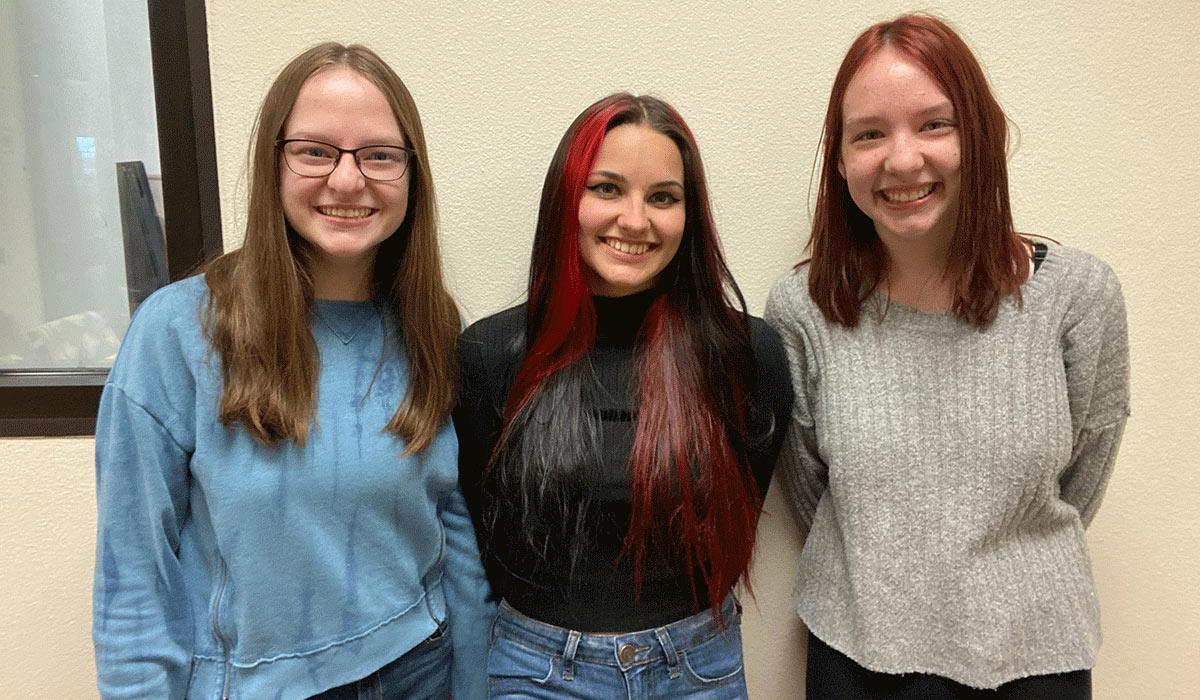
What did you do last weekend? For most people, catching up on homework, laundry or hanging out with friends and family is the norm. For TMCC High School students Amber Thompson, Samantha Thompson and Katarina Costa who are dually-enrolled at TMCC, a fourteen-hour mathematics challenge is par for the course. For these advanced mathletes—or STEM-Superstars to be sure—the MathWorks Math Modeling Challenge (or M3 Challenge for short) was a fourteen-hour foray into creating a mathematical model for answering a complex question.
“We had one weekend in which we could select a 14-hour block of time that had to be uninterrupted to open this problem and try to come up with multiple different solutions,” explained Thompson. “The problem we were tasked with solving had to do with three questions that had to do with remote work.”
The questions posed to participants of the M3 Challenge are centered on real-world problems, which demand that the high school juniors and seniors in the United States, England, and Wales learn what it’s like to work on a team to answer the kinds of questions professional mathematicians do. In particular, it asks participants to do what is called “Math Modeling”—an open-ended method by which students create a valid, mathematical representation of a real-world scenario that can be used to make predictions.
According to the M3 website, one of the challenges, especially for younger students, is having good time management skills. “When modeling is new to students, it is easy for them to get overwhelmed. They may spend too much time ‘in the weeds.’”
What Can You Solve in Fourteen Hours?
On a Sunday morning—after presenting a research paper at a sectional meeting of the Math Association of America in Vallejo, California the day before—Thompson, Thompson and Costa opened their M3 Challenge question at approximately 9 a.m.
“We had to find what percentage of jobs were currently remote-ready, and then multiply that across multiple different years, cities. Then we had to create a math model that showed of the percentage of workers that have jobs that are remote-ready, what percentage of jobs would allow them to work remotely, what percentage of people would choose to work remotely, and then to combine that into one model to estimate over the six different cities, different years, which ones were most likely to be the most impacted,” Thompson explained.
If you’re already reeling from the pretzel-like structure of the problem, you’re not alone. And that’s really the first step in creating a mathematical model, and exactly what the trio decided to do first: make priorities and to delegate tasks to specific team members. Although the multi-faceted question presented many problems at once, the challenge that the trio faced was simply: none of them had ever created a mathematical model before.
“We thought it was going to be one question, one main model, but we ended up having to create multiple models,” Thompson said. “We ended up submitting everything with only two minutes before the deadline passed.”
The group would produce a 17-page paper to accompany the mathematical computations that enabled them to construct their model. Even though it was their first time creating a mathematical model, the group advanced to the second round of judging. To put this mathematically, they were among the top 18.5% of participants in the competition for a kind of collaborative open-ended computation that no one in the group had ever done before.
The following week, Thompson, Thompson and Costa would again push their limits of their math-muscles: they participated in a 48-hour MakerThon competition at UNR in which they worked with engineers to create a product. As if that wasn’t enough, it’s useful to keep in mind that all of these students are taking a full course load at TMCC. Their schedules include the kinds of classes that aren’t for the light of heart: Physics 2, Linear Algebra and Differential Equations.
“I really enjoy challenges like these—being presented with a problem and having to come up with a model and working in team situations like that,” said Costa, a high school senior who published her own math textbook last year, and who has been accepted to Stanford University next Fall. “It makes for a busy weekend for us... but I have loved solving puzzles my whole life, and so it’s like an application version of puzzles. To be honest, I love to do math in my free time.”
Words of Advice on How it Can Add Up to Success
Thompson, Thompson and Costa are graduating from TMCC High School in May 2022, each with at least 80 college credits. Although the lessons they’ll carry with them are many, they speak of letting go of perfectionism and looking for opportunities—because they exist all around us–lessons that rise to the top.
“It’s really about finding something and committing yourself to it,” Thompson said. “It’s so easy to be like: I know I said I was going to do this, but now I’m backing out. We decided to do these competitions and we were committed to it. And to be honest, there were a couple of times during these long competitions where we went completely in the wrong direction and we had to backtrack. It was a lot of trial and error. So, you don’t have to be a perfect student in order to do something like this.”
Collaboration, being open to new ideas—even outside perspectives—and accepting that you can make mistakes have been part of these students’ journeys that will undoubtedly lead them to become STEM leaders in the near future.
More than anything, the three insist that the time spent together solving these problems has been time well-spent. “It’s fun with friends,” Thompson said. “It’s important to make things like this fun... you just have to look for the right opportunities and be willing to say ‘yes’ to them.”
For more information about studying Mathematics at TMCC, contact the department at 775-673-7181.